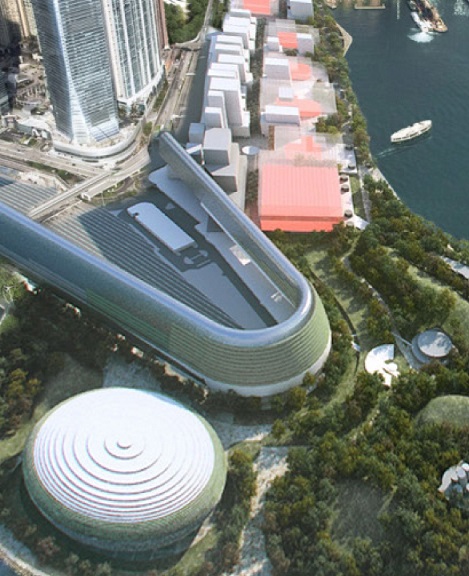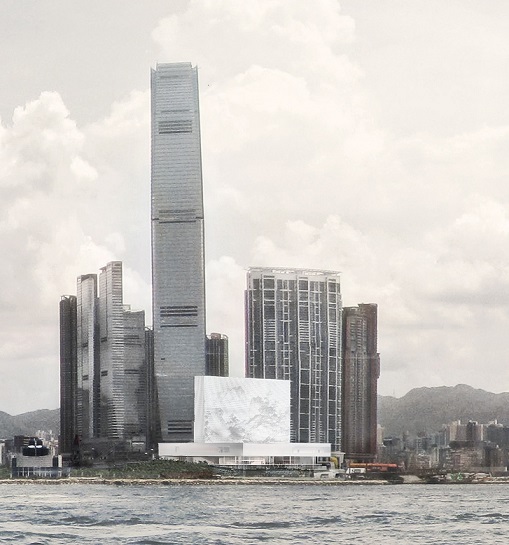Reviews & Articles
West Kowloon - A Downsizing Now?
John BATTEN
at 0:00am on 10th July 2013


Captions:
1. The park and original plan for cultural facilities - in the foreground is the Mega Performance Venue (large white circle), Freespace is the smaller half-circle inside the park and the huge 100-metre high parabolic shaped hotel that shields the park from the Western Harbour Crossing (this is one of the commercial facilities that will support the operating costs of WKCD).
2. Impression of new design of M+ by Heuzog & de Meuron and TFP Farrells seen from Victoria Harbour, 2013.
(原文以英文發表,討論西九文化區嚴重超資、基建及項目整體發展等問題。)
Amidst the fanfare of unveiling the new HK$4.9 billion design for M+, the planned museum for visual culture at the West Kowloon Cultural District, by Swiss architects Herzog & de Meuron and the British firm TFP Farrells, chairwoman of the WKCD Authority and Chief Secretary Carrie Lam Cheng Yuet-ngor last week also forewarned a pullback from the previous administration’s grand intentions for the site.
Responding to Legislative Council’s criticism of cost over-runs, Lam has committed the government to using the original HK$21.6 billion (invested, now HK$23 billion) funds approved by the Legco in 2008 to fund five anchor cultural facilities and park within the chosen Foster & Partners master plan for the site.
This is a firm commitment to only fund a “first batch of facilities” of the xiqu, or Chinese opera, centre; M+; the eastern portion of the West Kowloon park facing the waterfront, including an arts pavilion to be used by M+ while the museum is being built; Freespace, a black box theatre and an outdoor stage in the form of an acoustic shell, and a supposedly temporary modular performance venue seating 1,200 people. The target to complete these facilities is 2018. The revenue raising portions on the site, such as hotels, could also be built in this period.
There will be some money leftover from this initial building spurt – but not much: about HK$5 billion. Before a second batch of facilities – such as the proposed Lyric Theatre and other performing venues – can be built, underground roads and infrastructure must first be constructed. All this will require further government funding to be approved by Legco. The subtext of this situation is that there will be further public discussion about what will be built and how it is funded.
There is now a strong possibility that the entire project is downsized. Lam has cited “pragmatism” as the reason for these changes. This – and a dose of critical thinking – has long been lacking in the planning of the WKCD. An early criticism by the arts community was that any planned cultural district should be allowed to grow organically. Facilities could be added to the site over time as and when needed.
The previous administration, headed by Donald Tsang Yam-kuen, rushed the West Kowloon Cultural District Authority Ordinance through the legislature in 2008 and although WKCD now has a strong management structure in place, the important issue of governance of individual facilities was never resolved.
The initiative to implement this is the responsibility of the Home Affairs Bureau, whose policy-making lacks muscle in the government hierarchy. An irony in the promotion of WKCD has been the government’s own rhetoric to get it built quickly. Lam again repeated this urgency last week. The main reason for delays has been its own vacillation on funding and indecision about the mixture of facilities to be built.
Also, the biggest physical obstacle causing a delay in construction has also been access onto the WKCD site itself – as the MTR currently has possession of a large area of the WKCD near Austin Road to build its own infrastructure for the controversial high-speed cross-border rail link (due for completion in 2015). This simple fact has been quietly downplayed as the funding for this train project was itself passed by Legco amidst uproar about its efficacy, public protests and the filibuster-blocking rulings by Legco president Tsang Yok-sing.
While there has been an unrealistic atmosphere of expectation pervading the WKCD project over the last five years, Lam’s “pragmatic” approach now brings the project within the Leung Chun-ying administration’s own gambit.
The multi-billion-dollar arts hub, a Tsang legacy promoted by Henry Tang Ying-yen, could easily have become a sidelined project without the personal interest of Lam herself and energetic programming by WKCD staff over the last 12 months. Some legislators have exploited the government’s ambivalence, gaining political mileage by attacking the project. Lam’s latest announcement puts the project on a much sounder footing with stronger support from the Leung administration for the core facilities.
However, without any guaranteed future funding, the second phase construction could be stuck in limbo.
Lam has also suggested that a mixture of future performing arts venues could be privately funded with naming rights. This seems an unlikely route for the Leung administration while it has an uneasy relationship with both Legco and property developers.
While the latest proposal to increase the site’s density will not affect the park or cultural facilities, it will increase the bulk and height in the hotel, residential and commercial zoned areas of the site. These buildings are specifically built as a long-term funding source to operate the site’s cultural facilities. Whether an application to the Town Planning Board is made to increase the site’s plot ratio will hinge on the site’s new funding requirements and the mixture of performance arts venues to be built in the second phase of construction – which all remain unknown.
Last year, the Town Planning Board approved the master plan that only allows the site to be served by underground roads and infrastructure facilities. Lam has now clarified that government will fully pay for these underground facilities, but will, again, need Legco approved funding.
There are other niggling issues.
The proposed “great” park under the site’s master plan is designated as “open space” by the Town Planning Board, but the building of Freespace and a modular arts venue is not allowed under this zoning designation. The WKCD Authority will argue that these buildings are “temporary” – this is debatable and could be a future flashpoint if pursued. The one area of community consensus about WKCD is that the site must contain a large open urban park. Such a park needs lots of open space and these facilities could easily be relocated.
But one of the outcomes of Lam’s announcement is the government may now propose a longer timeframe to develop the WKCD site – similar to the arts community’s original lobbying for an organic approach.
This approach would provide Hong Kong with a world-class museum, some smaller but useful performance venues and the possibility of an enlarged and magnificent Harbour-side park – with the flexibility to change into the future.
A version of this article was published in the South China Morning Post, 9 July 2013.
|
|
|
|
|
|
